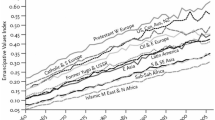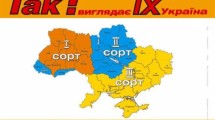Abstract
This paper maps superheroes as signifiers of substantive justice and their relationship with the state across two Coverian nomoi, World War II and the “war on terror”. It is argued that the central concern of most superhero narratives is justice, exploring both what it means and how it can best be articulated. This “call to do justice” (to borrow Douglas Litowitz’s phrase) becomes even more important during wartime where superheroes become agitators for cultural change, appropriating the sovereign decision during states of exception even as they resist co-option by the state itself.
Similar content being viewed by others
Notes
This article is therefore adopting a pragmatic view of justice as the “correct” or “fair” result, predicated on the notion that something is “just” when individuals get what is due to them, a definition that applies to both of these notions of justice. In part the article plays into the debates around moral relativism in accepting that justice does have a different meaning depending on where it is found—though in this case this is produced more by its relationship with law than its social or cultural context.
Some commentators extend this to 1949 when once-popular characters were retired.
Decker [19] notes that the Golden Age quite clearly attaches to the superhero genre as horror, western, romance or funny animal comics would have their own “golden ages” covering quite different periods of time, yet these are never referred to as such (despite comics actually reaching an all-time sales high during the early 1950s).
The superheroes returned to popularity in what is popularly referred to as the “Silver Age”, commencing with the debut of Barry Allen as the Flash in “Mystery of the Human Thunderbolt!” (Showcase 4 October 1956) and gaining momentum with Marvel Comics’ Fantastic Four in 1961.
Arguably the most famous war comic of all, DC’s Sgt. Rock (commencing publication in 1959), could be included here as it occurs well after the Golden Age period and, for most of its run, brings a gritty realism and, later, a Vietnam sensibility to World War II.
In SHAZAM each letter represents the name of a mythical hero - Solomon, Hercules, Atlas, Zeus, Achilles and Mercury—from which Captain Marvel derives his wisdom, strength, stamina, power, courage and speed.
Naturally when supervillains team up they call themselves the Injustice Society.
Though it should be noted that this comment was made well in advance of the September 11 attacks and Frank Miller may revise such an assertion in the current political climate, it still highlights the reason why we may consider some articulations of substantive justice “heroic” and others as “terrorist acts.”
In DC Comics, the magic properties of acquired artifacts such as Hitler’s Spear of Destiny and Tojo’s Holy Grail protected the Axis countries from direct superheroic intervention.
The title ended in 1950 (after 75 issues) and was briefly revived (for 3 issues) in 1956 with the subtitle “commie smasher”.
Captain America was not the first patriotic hero (that was MLJ’s The Shield) but he was certainly the most popular and inspired slews of imitators, amongst them Uncle Sam, Superpatriot, the Fighting American, General Glory, etcetera.
Pillar [36] notes that this is very much a product of the times. Post Watergate and the Pike and Church committees there had been a curtailing or controlling of executive power rather than an expansion (6).
Full Citation: The ‘Uniting and Strengthening America by Providing Appropriate Tools Required to Intercept and Obstruct Terrorism (USA PATRIOT ACT) Act of 2001’ (HR 3162).
References
Agamben, Giorgio. 2005. The state of exception. Chicago, IL: University of Chicago Press.
Agamben, Giorgio. 1998. Homo Sacer: Sovereign power and bare life. Standford, CA: Standford University Press.
Badiou, Alan. 2001. Ethics: An essay on the understanding of evil. Trans. P. Hallward. London and New York: Verso.
Bainbridge, Jason. 2012. Spider-Man, the question and the meta-zone: Exception, objectivism and the comics of Steve Ditko. Law Text Culture 16: 217.
Bainbridge, Jason. 2007. ‘This is the authority. This planet is under our protection’—An exegesis of superheroes’ interrogations of law. Law, Culture and the Humanities 3: 455.
Balkin, Jack. 1994. Transcendental deconstruction, transcendental justice. Michigan Law Review 92: 1131.
Bendis, Brian Michael. 2004. Ultimate six. New York, NY: Marvel Comics.
Benton, Mike. 1989. The comic book in America: An illustrated history. Dallas, TX: Taylor Publishing Company.
Berger, Benjamin L. 2008. On the book of job, justice and the precariousness of the criminal law. Law Culture and the Humanities 4: 98.
Bernstein, Richard J. 2005. The abuse of evil: The corruption of politics and religion since 9/11. Cambridge: Polity Press.
Bush, George W. 2005. Second inaugural address. http://www.whitehouse.gov/news/releases/2005/01/20050120-3.html.
Campbell, Joseph. 1971 [1949]. The hero with a thousand faces. London: Penguin.
Chaykin, Howard. 1995 [1993–1994]. “Introduction” in James Robinson. The golden age. New York, NY: DC Comics. 3–7.
Coogan, Peter. 2006. Superhero: The secret origin of a genre. Austin, TX: Monkeybrain Press.
Cover, Robert. 1986. Violence and the word. Yale Law Journal 95: 1601.
Cover, Robert. 1983. The Supreme Court, 1982 term—forward: Nomos and narrative. Harvard Law Review 97: 4.
Daniels, Les. 1991. Marvel: Five fabulous decades of the world’s greatest comics. New York, NY: Harry N. Abrams.
Daniels, Les. 1971. Comix: A history of comic books in America. New York, NY: Bonanza.
Decker, Dwight R. 1987. The golden age of comics is twelve. Amazing Heroes 115: 72–73.
Derrida, Jacques. 1992. Force of law: The ‘mystical foundation of authority’. In Deconstruction and the possibility of justice, ed. Drucilla Cornell, Michael Rosenfield, and David G. Carlson. New York and London: Routledge.
Derrida, Jacques. 1994. Specters of Marx. Trans. Peggy Kamuf. New York and London: Routledge.
Evanier, Mark. 2001. Introduction. The blackhawk archives. Volume 1. New York, NY: DC Comics.
Faludi, Susan. 2007. The terror dream: Fear and fantasy in post-9/11 America. New York, NY: Metropolitan Books.
Feiffer, Jules. 2003 [1965]. The great comic book heroes. Washington, DC: Fantagraphics Books.
Hughes, Bob. 1998. Dilemma of the ductile detective or… why isn’t plastic man one of DC’s hottest stars? Amazing Heroes 150: 41–49.
Jones, Gerard. 2004. Men of tomorrow: Geeks, gangsters and the birth of the comic book. London: Heinemann.
Litowitz, Douglas E. 1997. Postmodern philosophy and law. Lawrence, Kansas: University Press of Kansas.
McCallum, Pat (editor-in-chief). 2003. Wizard: The comic magazine zero. New York, NY: Gareb Shamus Enterprises. 1: 0.
Millar, Mark. 2000. O Brave New World! SFX Superhero Special. 108–110.
Millar, Mark. 2003. The ultimates, 2003–2004. New York, NY: Marvel Comics.
Millar, Mark. 2004–2005. The Ultimates 2. New York, NY: Marvel Comics.
Miller, Frank. 1996. Batman: The dark knight returns. New York, NY: DC Comics.
Minear, Richard H. 2001. Dr. Seuss goes to war: The World War II editorial cartoons of Theodore Seuss Geisel. New York, NY: New Press.
Mougin, Lou. 1988. The captain America chronicles—part 1. Amazing Heroes 146: 31–41.
Osiel, Mark. 2009. The end of reciprocity: Terror, torture, and the law of war. Cambridge: Cambridge University Press.
Pillar, Paul R. 2005. Perceptions of terrorism: Continuity and change. Law vs. war: Competing approaches to fighting terrorism. Conference report. July. http://www.carlisle.army.mil/ssi.
Reyns, Bradford W., and Billy Henson. 2010. Superhero justice: The depiction of crime and justice in modern-age comic books and graphic novels. Sociology of Crime, Law and Deviance 14: 45.
Robinson, James (w), Paul Smith (a). 1995 [1993–1994]. The golden age. New York, NY: DC Comics.
Rushkoff, Douglas. 1994. Media virus: Hidden agendas in popular culture. New York, NY: Random House.
Sanderson, Peter. 1998. A tale of two captains (interview with Mark Gruenwald). Amazing Heroes 146: 21–31.
Schell, Jonathan. Letter from ground zero: September 27, 2001. The Nation. October 15 2001. http://www.thenation.com/article/letter-ground-zero-38#. Accessed 13 Apr 2015.
Schmitt, Carl. 2005. Political theology: Four chapters on the concept of the sovereignty. Chicago, IL: University of Chicago Press.
Siegel, Jerry (w) and Joe Shuster (a). 2006. The superman chronicles: Volume one. New York, NY: DC Comics.
Slott, Dan. 2004–2005. She-Hulk. New York, NY: Marvel Comics.
Tushnet, M. 1996. Class Action. In Legal reelism: Movies as legal texts, ed. John Denvir. Chicago, IL: University of Illinois Press.
Wendt, Alex. 1999. Social theory of international politics. Cambridge: Cambridge University Press.
Author information
Authors and Affiliations
Corresponding author
Rights and permissions
About this article
Cite this article
Bainbridge, J. “The Call to do Justice”: Superheroes, Sovereigns and the State During Wartime. Int J Semiot Law 28, 745–763 (2015). https://doi.org/10.1007/s11196-015-9424-y
Published:
Issue Date:
DOI: https://doi.org/10.1007/s11196-015-9424-y




